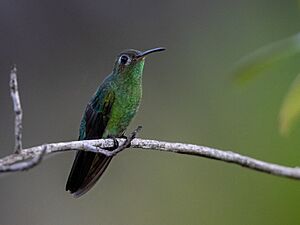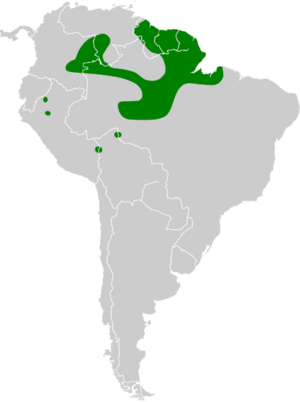Green-tailed goldenthroat facts for kids
Quick facts for kids Green-tailed goldenthroat |
|
|---|---|
 |
|
| Conservation status | |
| Scientific classification | |
| Genus: |
Polytmus
|
| Species: |
theresiae
|
 |
|
| Range of Polytmus theresiae | |
The green-tailed goldenthroat is a beautiful type of hummingbird. Its scientific name is Polytmus theresiae. This tiny bird lives in several South American countries. You can find it in Bolivia, Brazil, Colombia, French Guiana, Guyana, Peru, Suriname, and Venezuela. It might also live in Ecuador.
Contents
About the Green-tailed Goldenthroat
This hummingbird belongs to a group called "mangoes" within the hummingbird family. Scientists have studied its family tree for a long time. They first placed it in its own group. Later, it joined the Polytmus group.
Types of Green-tailed Goldenthroats
There are two main types, or subspecies, of the green-tailed goldenthroat. They are called P. t. theresiae and P. t. leucorrhous. They are very similar but have small differences.
What Does It Look Like?
The green-tailed goldenthroat is a small bird. It is about 8.9 to 9.9 centimeters (3.5 to 3.9 inches) long. It weighs only 3.0 to 3.9 grams (0.11 to 0.14 ounces). Both male and female birds have a long, slightly curved bill. This bill is pinkish with a black tip.
Male and Female Birds
The male bird of the main subspecies is mostly shiny green. Its tail is rounded and green. Most tail feathers have a white spot at their base. The area around its eyes is dark gray. It also has a small white spot behind each eye.
The female bird is a bit smaller than the male. Her throat and chest are whitish. They have many green spots. The outer tail feathers on a female have white tips. Young birds look like the adult female. They have buffy (light yellowish-brown) edges on their head feathers.
Subspecies Differences
The P. t. leucorrhous subspecies looks almost the same as the main one. The main difference is that it has a white area under its tail.
Where Do They Live?
The main subspecies, P. t. theresiae, lives in a region called the Guianas. This includes parts of French Guiana, Guyana, and Suriname. It also lives in north-central Brazil. This area stretches from the lower Negro and Madeira rivers. It goes east into the states of Pará and Amapá.
The P. t. leucorrhous subspecies lives in eastern Colombia and southern Venezuela. It is also found in the upper Negro River area of Brazil. Separately, it lives in eastern Peru and northern Bolivia. Some experts think it might also be in Ecuador.
Their Home Environment
These hummingbirds like to live at the edges of sand-soil forests. They also enjoy sandy savannas. These savannas have scattered small trees and bushes. They usually live at elevations between 100 and 300 meters (330 and 980 feet) above sea level.
Behavior
Movement and Travel
The green-tailed goldenthroat usually stays in one place. It does not travel far. However, some birds have been seen moving to coastal mangrove areas in Suriname. This happens during January and February.
How They Find Food
This hummingbird mostly feeds by "trap-lining." This means it visits a set path of flowering plants. It goes from one flower to another to drink nectar. It especially likes flowers from the Melastomataceae plant family. Male birds sometimes protect their favorite feeding spots. Both male and female birds also catch arthropods (like insects) while flying. They also pick them off leaves.
Reproduction and Life Cycle
The breeding season for the green-tailed goldenthroat changes depending on where they live. In the Guianas, they breed in March, April, and from August to October. In Venezuela, it's October and November. In Brazil, it's from November to March.
Only the female bird builds the nest. She also sits on the eggs to keep them warm. And she takes care of the young birds. The nest is a small cup. It is made of fine plant fibers and spider silk. She builds it in the fork of a low bush. A female usually lays two eggs. The eggs hatch after about 14 days. The young birds leave the nest (fledge) about 20 to 28 days after hatching.
Their Calls and Songs
The green-tailed goldenthroat's song is a long, repeated sound. It sounds like a whinny. It has 20 to 25 notes. The song first rises in pitch, then falls slightly. It fades away at the end. It usually starts with a single note. The birds in Peru sing a similar song, but it is faster and has trills. They also make single "tsit" sounds.
Conservation Status
The IUCN (International Union for Conservation of Nature) has looked at the green-tailed goldenthroat. They say it is a species of "Least Concern." This means it is not currently in danger of disappearing. However, scientists do not know exactly how many of these birds there are. They also don't know if their numbers are growing or shrinking. In the northern parts of its range, this bird is common. In some places, there are many of them.


